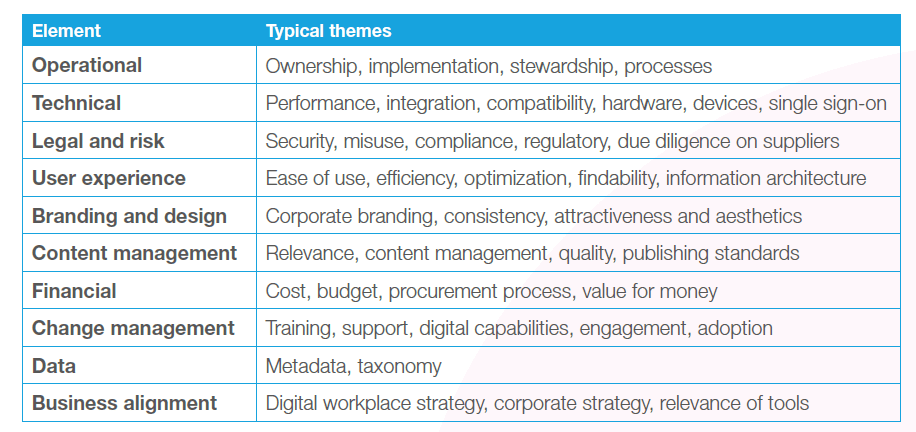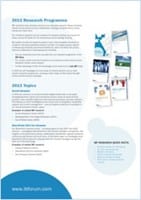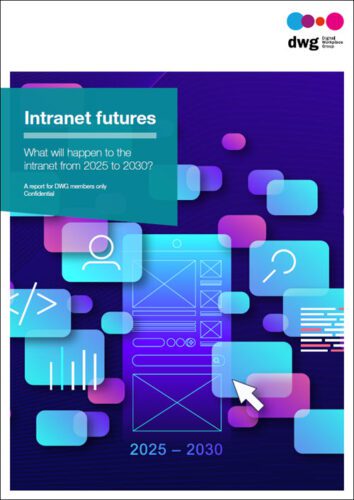Five ways to move forward with digital workplace governance
 For anybody wanting to advance their digital workplace, establishing some governance is essential. You need the right processes, structures and rules in place to underpin and drive a better, more effective and consistent user experience of your digital ecosystem.
For anybody wanting to advance their digital workplace, establishing some governance is essential. You need the right processes, structures and rules in place to underpin and drive a better, more effective and consistent user experience of your digital ecosystem.
But digital workplace governance can be challenging. How do you get it set up in the first place? And once you have managed to put in place a robust governance framework, how do you make it sustainable?
First of all, don’t panic!
If you’ve already experienced battles with establishing intranet governance in the past, then the thought of applying similar principles and practices across a far wider portfolio of applications and channels may make you feel like the subject of Edvard Munch’s famous painting, “The Scream”.
However, if you’re already feeling like this is too big a mountain to climb, try not to panic! Very few organizations can truly say they are advanced in this field. As with all things digital workplace, this is still very much an emergent field. Whether your digital workplace and the associated governance are mature, or merely a twinkle in the eye of a group of enlightened stakeholders, there are inevitably things you can do to advance digital workplace governance.
What does digital workplace governance cover?
Our recent member research into digital workplace governance looks at some of the critical components you need in order to get this right. The report defines digital workplace governance as “the policies, structures, roles, rule, processes and standards that need to be applied for the digital workplace to run optimally and be sustainable”. To this list one could add such components as “having a strategy in place”, “tactics to implement a governance framework” and “measurement to track progress”.
The report also looks at the different elements and related themes that need to be considered in any framework:

At first glance, with this potential wide scope, the task of progressing the digital workplace can seem daunting, but here are five ideas on how to get this moving in your organization.
1. Get governance on the agenda of key stakeholders
One key challenge related to digital workplace governance is that its scope inevitably cuts across different channels and responsibilities, spanning the remit of multiple stakeholders. As we established in our earlier “Digital Workplace Fundamentals” report, taking a cross-functional approach is essential. It will be necessary to co-operate with friends and colleagues in IT, HR, Marketing and Communications, Knowledge Management, Research and Development, and more.
Realistically, if the digital workplace isn’t already on people’s agenda, then preparatory work may need to be done. At DWG we’ve found that a workshop involving different stakeholders, where everyone can learn about the concepts and share their views on the digital workplace, is a good starting point to get it on the agenda and start driving things forward. From this it will become clear that governance is very important, even if the specifics are not yet being discussed.
2. Underpin with the right structures
At the core of digital workplace governance lie the structures that own, define, deliver and enforce it. But this is easier said than done, especially at the start when there is no established “owner” of the digital workplace. The closest you will probably get is the IT department, in terms of infrastructure, but even then this will likely exclude third-party applications in the cloud. Internal Communications or HR may have responsibility for “employee experience” but this rarely crosses over into technology. You may also have a user experience (UX) team, but their focus will usually be tactical rather than having a strategic mandate.
Digital workplace governance needs cross-functional structures that meet regularly and eventually have a mandate to set standards and rules. The way these structures are set up will probably not look a million miles away from those already in place for other workplace initiatives, including your intranet. You may have a steering committee focused on strategy and big decisions, a committee which is more operationally focused, and a delivery team.
If you’re not yet far down the line with the digital workplace, having some sort of formalized group with representation from senior stakeholders will help move governance forward. Our sense is that this should be a new group – not the one that already covers your intranet – otherwise the digital workplace may just be regarded as an intranet rebranding exercise.
3. Articulate a framework
So, what does digital workplace governance look like? If strategy is the big picture vision and the roadmap is the exciting projects and outcomes that arise out of that strategy, then governance is the boring small print that senior executives don’t have time to read! It’s the nerdy, quiet cousin to the more exciting vision of the future of work. But without governance your digital workplace initiative will fail.
Articulating how governance might actually work in practice can help stakeholders grasp what needs to be done. Sometimes this governance needs to be put in place before projects are implemented, so it is important to ensure that this is an area of focus. Some of the key questions to consider are:
- What is the scope of digital workplace governance?
- What channels and applications does it cover?
- Is change management part of the governance framework? (It should be!)
- What are the key roles? Who is the overall owner and sponsor?
- What measurement will be in place?
- How is governance different for applications and content?
- How does governance change over application and content lifecycles?
- How centralized or decentralized is governance?
4. Learn from what already works
At DWG, we believe that all organizations already have a digital workplace and an associated experience. From organization to organization these will all be at different stages as regards maturity, coherence, personalization, and so on.
Inevitably, there will be governance in place for different elements of the existing digital workplace, some of which may work very well. For example, some IT departments have implemented convincing SharePoint governance, while other organizations might have robust governance in place for their employee mobile app store.
Learning from what already works can provide clues as to how digital workplace governance could function in your organization. It helps stakeholders to visualize new structures or perhaps think about how existing ones can be built upon or expanded. In our research case studies, a recurrent theme is that, once digital workplace governance has matured and gone into the “business-as-usual” phase after a programme or project, it tends to be folded into the governance processes already in place.
5. Start somewhere
We believe that some digital workplace governance is better than no digital workplace governance – and that in order to move this forward you need to start somewhere.
At DWG we come across many forward-thinking intranet teams – at various stages of their digital workplace journeys – who are pushing this issue up the strategic agenda. They may be trying to influence stakeholders, or perhaps rebrand the intranet as a digital workplace, or maybe they are just pushing hard for standards to be applied to new applications that are primarily accessed via the intranet. Whatever the objectives, they are helping to move the agenda forward.
Digital workplace governance is the way to go. As many organizations start to move from the strategizing to the implementation phases of their digital workplace initiatives, we’re going to see governance emerge more and more as a major theme. We’d love to know how you’re getting on with this in your organization – do let us know in the comments below!
Related resources
- 7 ‘protips’ for digital workplace professionals from a video gamer
- The link between culture and the digital workplace
- A checklist for your digital workplace roadmap
- Data and metrics in a world of ‘digital workplace opinion
Cost
This report is included in DWG’s annual membership. If you are already a member, download the full report on the DWG extranet.
Find out more
If our member research has sparked your interest, contact us to explore becoming a DWG member. We will gladly help you understand which options will best meet your needs and budget.
Learn about membership
Categorised in: Digital workplace, Digital workplace strategy, Research reports


